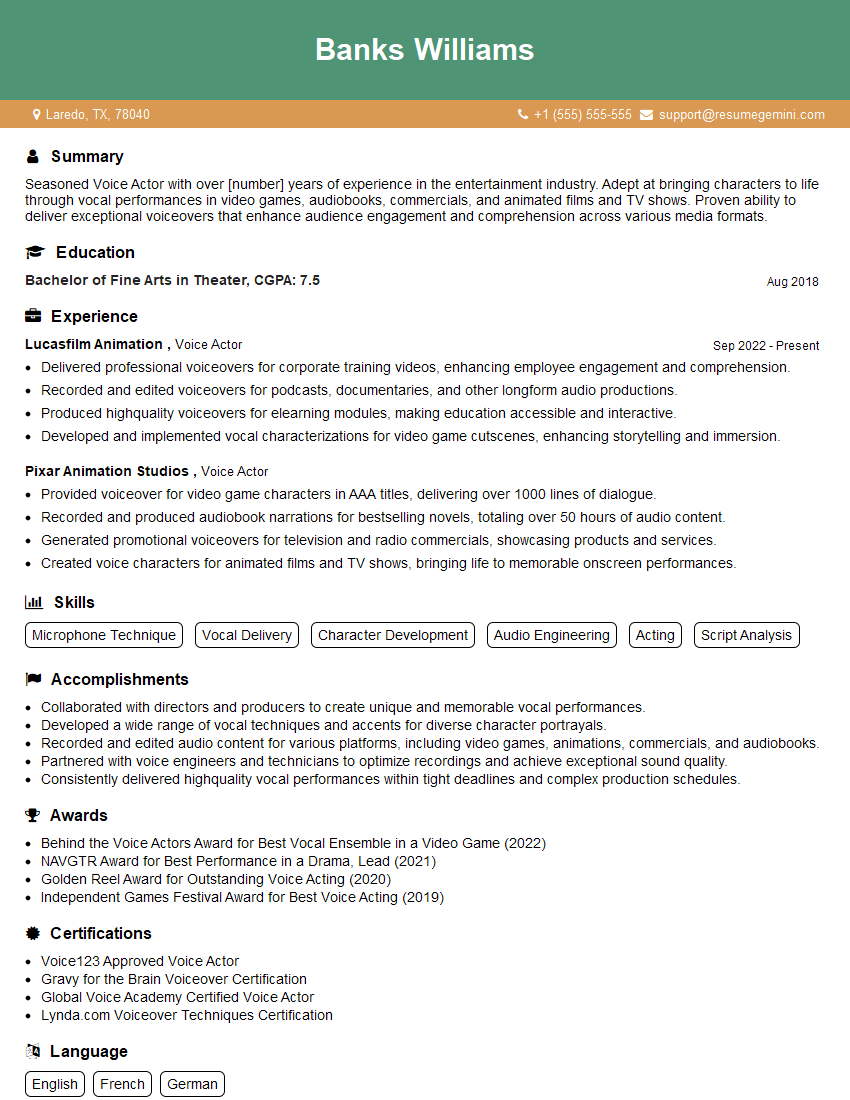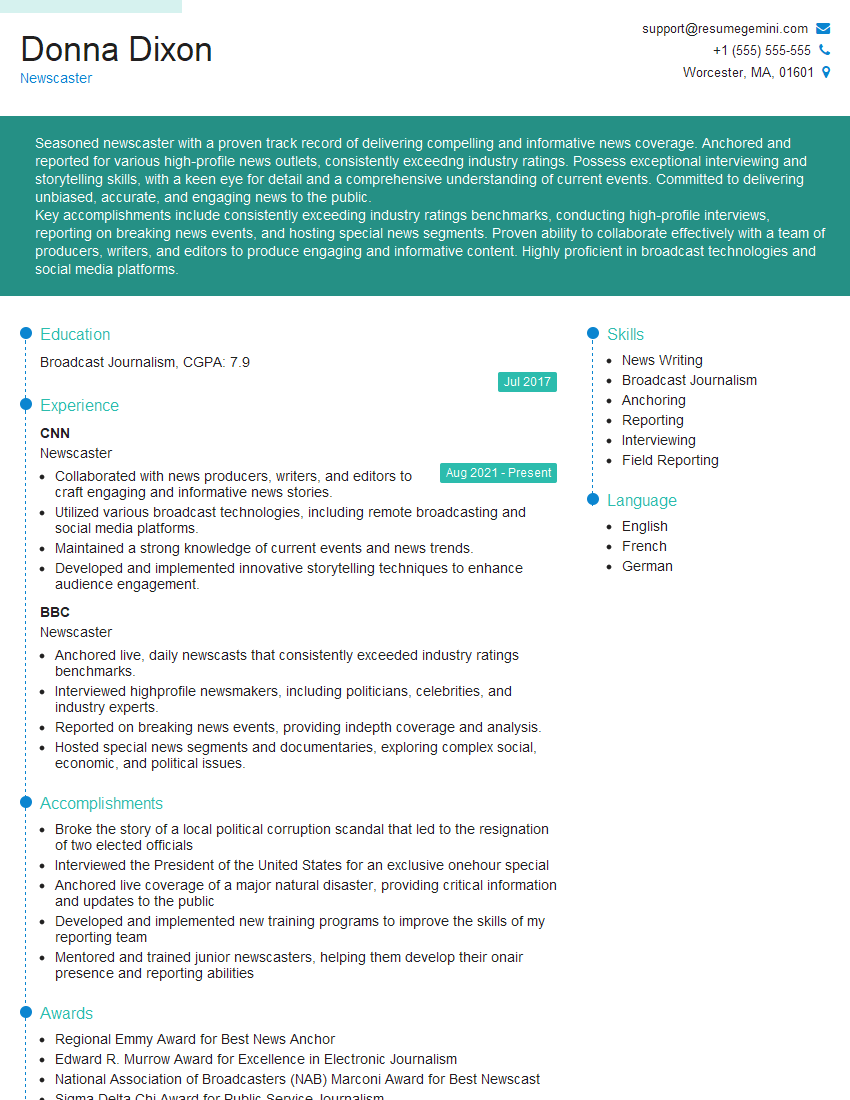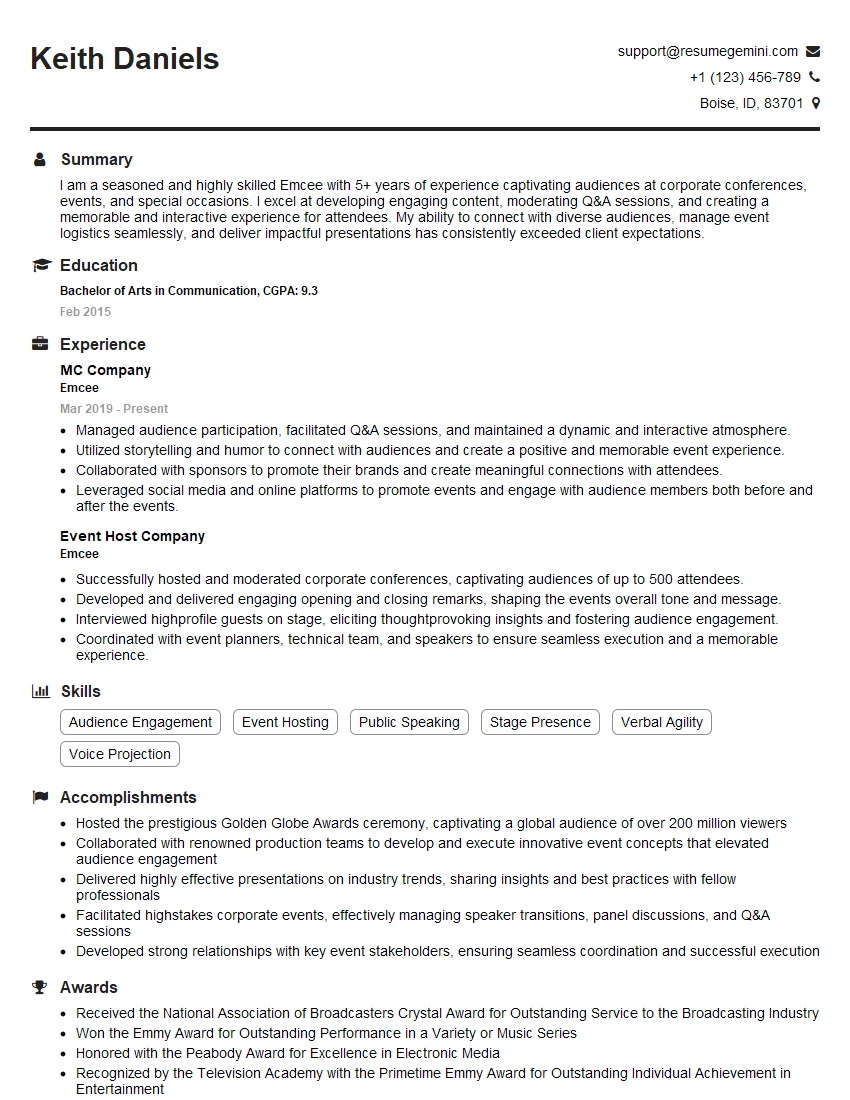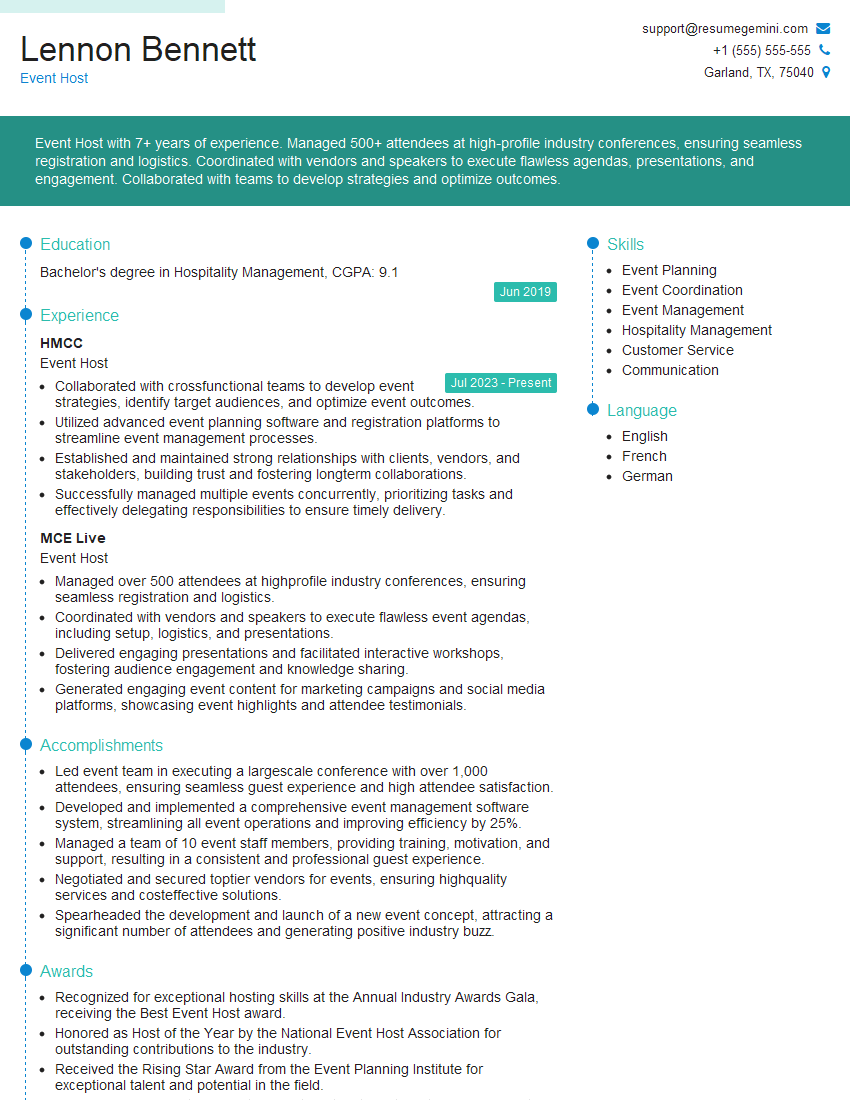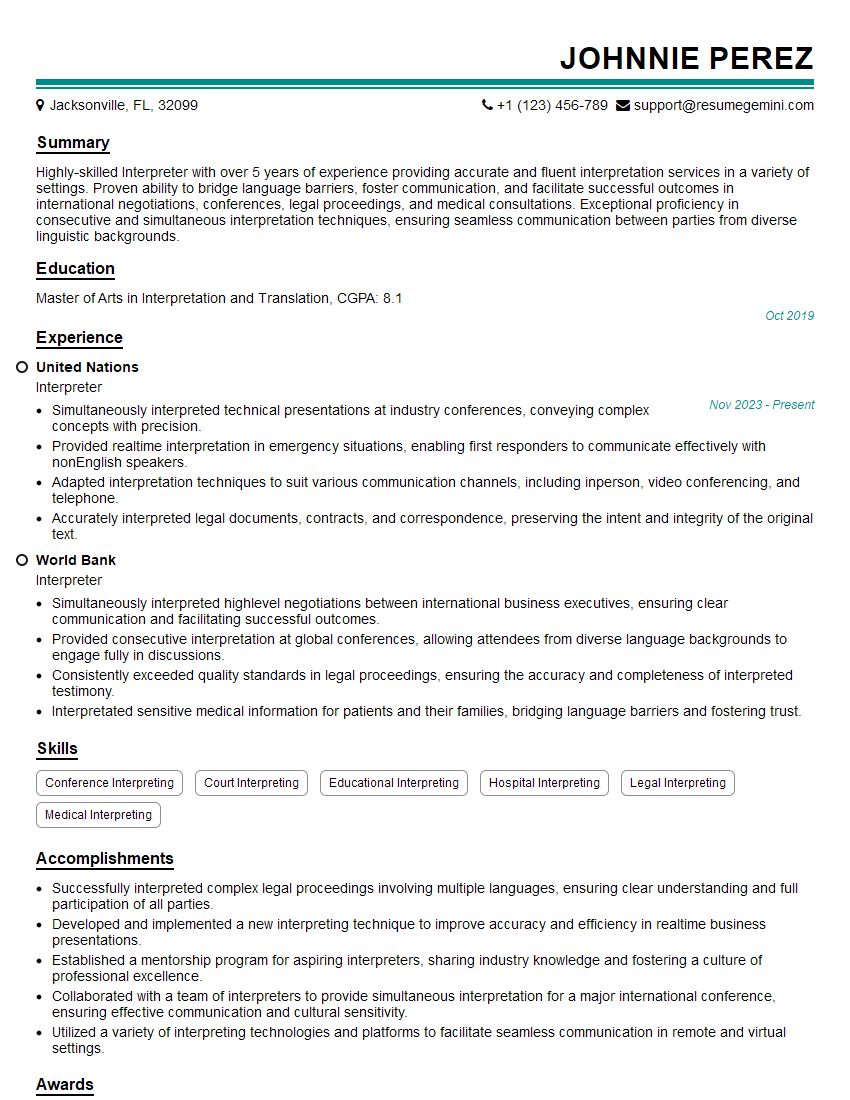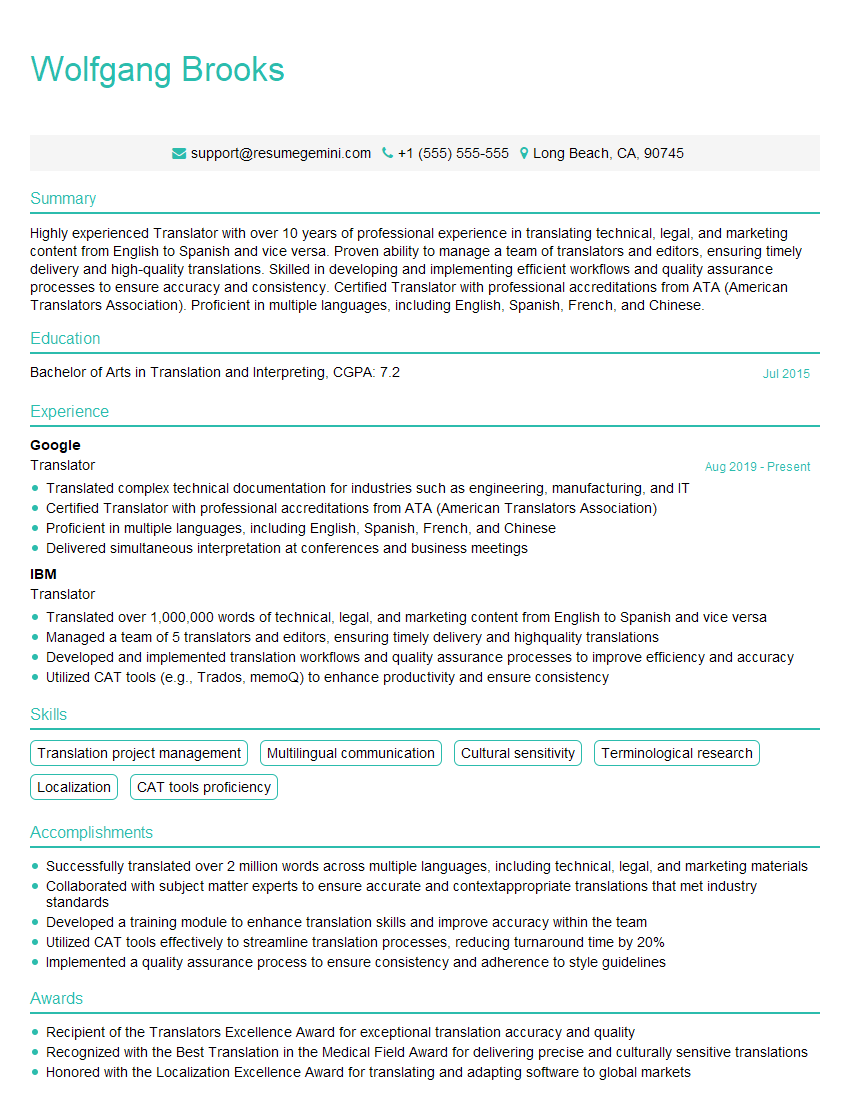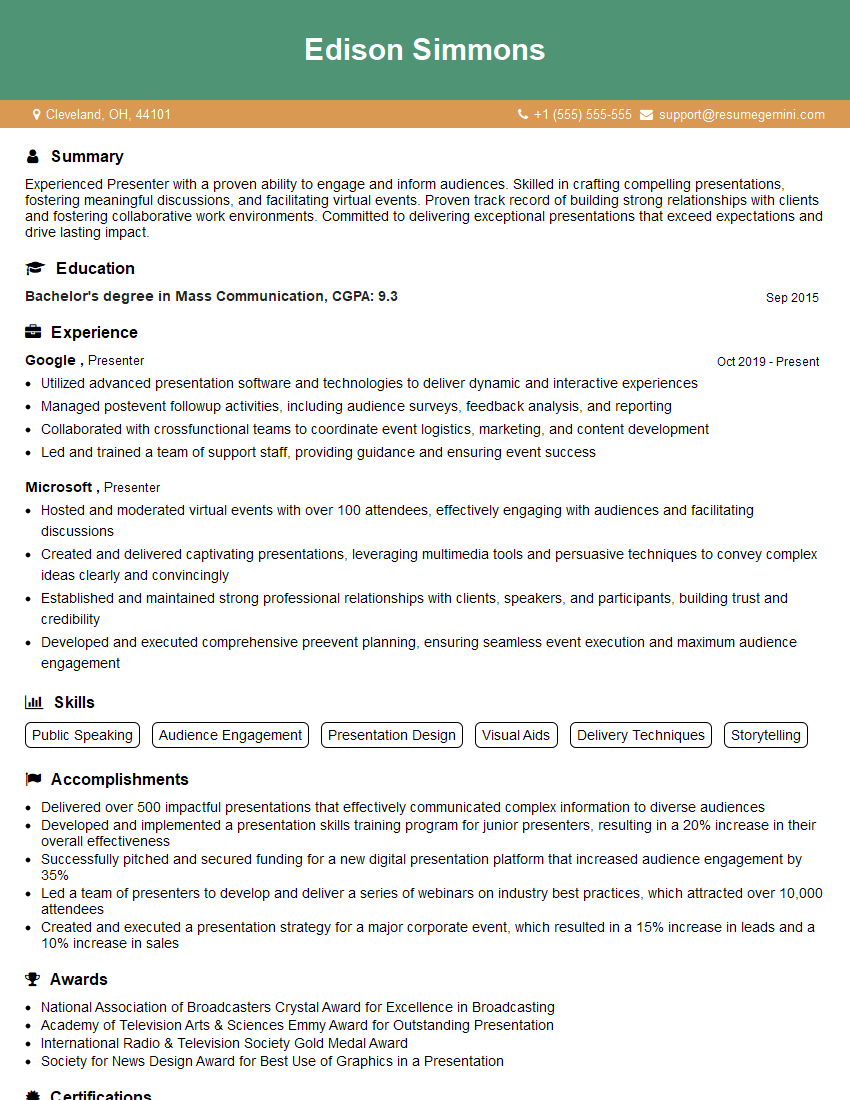Preparation is the key to success in any interview. In this post, we’ll explore crucial Passion for the spoken word and performance interview questions and equip you with strategies to craft impactful answers. Whether you’re a beginner or a pro, these tips will elevate your preparation.
Questions Asked in Passion for the spoken word and performance Interview
Q 1. Describe your vocal range and flexibility.
My vocal range is quite extensive, spanning approximately two and a half octaves, from a comfortable low baritone to a reasonably high tenor. This gives me significant flexibility in adapting my delivery to different material and moods. For instance, I can easily shift from a deep, resonant voice for dramatic storytelling to a lighter, more conversational tone for humorous anecdotes. Furthermore, I’ve worked extensively on breath control and vocal placement, which allows for nuanced control over volume, pitch, and timbre. This is crucial for conveying emotional depth and avoiding vocal strain during extended performances.
Think of it like a musical instrument – the wider the range, the more versatility you have in creating a compelling performance. I regularly practice vocal exercises to maintain and expand this range, ensuring I’m always at my peak performance level.
Q 2. Explain your experience with different microphone techniques.
My experience with microphones encompasses a variety of techniques crucial for optimal sound quality and projection. I’m proficient with both dynamic and condenser microphones, understanding their unique characteristics and applications. Dynamic mics, known for their robustness and feedback resistance, are ideal for loud environments like live shows. Condenser mics, offering greater sensitivity and detail, are perfect for studio recordings where capturing subtle nuances is critical.
I understand the importance of proper microphone technique, including maintaining appropriate distance, avoiding plosives (harsh consonant sounds like ‘p’ and ‘b’), and utilizing different microphone positions (e.g., close-miking for intimacy, further away for a more natural sound). I’ve worked with various microphone stands and boom arms, adapting my positioning to optimize sound and minimize unwanted noise.
For instance, during a recent live podcast recording, I used a cardioid dynamic microphone mounted on a boom arm, strategically positioned to minimize background noise while ensuring clear audio pickup. This involved careful placement to avoid feedback and adjusting my distance from the mic to maintain consistent volume.
Q 3. How do you manage stage fright or performance anxiety?
Stage fright is a common experience, even for seasoned performers. My approach to managing performance anxiety is multifaceted. Firstly, I rely heavily on thorough preparation. Knowing my material inside and out significantly reduces anxiety. Secondly, I employ relaxation techniques, such as deep breathing exercises and mindfulness practices, to calm my nerves before a performance.
Visualization is another powerful tool. I mentally rehearse the performance, imagining a successful outcome, which helps build confidence. Finally, I’ve learned to embrace the nervous energy as excitement rather than fear. It’s a physiological response that, when channeled correctly, can actually enhance my performance. I treat each performance as an opportunity for growth and self-expression, shifting my focus from fear of failure to the joy of sharing my passion.
Q 4. What is your process for preparing a speech or presentation?
My preparation process involves several key stages. It begins with a deep understanding of the material – be it a speech, poem, or story. This involves careful analysis of the text, identifying its central themes, emotional arc, and intended message. I then determine the overall tone and style of delivery appropriate for the piece and the audience.
Next, I engage in multiple rehearsals, paying close attention to pacing, intonation, and emphasis. I work on incorporating effective pauses, vocal variety, and body language to enhance engagement. I also record myself during rehearsals to identify areas for improvement. Finally, I conduct mock performances, either to a small audience or using a video recording, to refine my delivery and build confidence. This iterative process, refining the performance through feedback and repetition, allows me to present a polished and impactful final product.
Q 5. How do you adapt your delivery to different audiences?
Adapting my delivery to different audiences is paramount. I tailor my approach based on factors like age, background, and the context of the performance. For instance, a speech to a group of academics would demand a more formal and precise delivery, using sophisticated vocabulary and a structured presentation style. Conversely, a storytelling session for children would necessitate a more playful and interactive approach, utilizing a more conversational tone and employing visual aids or storytelling techniques.
Understanding the audience’s prior knowledge and their expectations is also critical. I gauge their level of familiarity with the topic and adjust my language and depth of explanation accordingly. Active observation of audience feedback – their reactions, body language – allows for real-time adjustments to maintain engagement and keep the delivery relevant and impactful.
Q 6. Describe a time you had to improvise during a performance.
During a recent impromptu performance at a community event, the audio system unexpectedly malfunctioned mid-speech. Instead of panicking, I quickly assessed the situation. Realizing the microphone was dead, I seamlessly transitioned to a more intimate style, projecting my voice naturally to the smaller immediate audience. I adjusted my delivery, focusing on storytelling elements and incorporating audience interaction to maintain engagement despite the technical difficulties. The audience responded positively, appreciating the flexibility and adaptability in the face of an unexpected challenge. This experience reinforced the importance of remaining calm, thinking on your feet, and leveraging your skills to overcome obstacles in a performance setting.
Q 7. How do you incorporate emotion and expression into your delivery?
Incorporating emotion and expression is central to my performance style. It’s not simply about reciting words; it’s about conveying the story’s essence and resonating with the audience on an emotional level. This begins with a deep understanding of the text and the characters involved. I analyze the nuances of emotion expressed in the language, and translate them into vocal inflection, body language, and pacing.
For example, I might use a slower tempo, lower pitch, and softer volume to convey sadness, while employing a faster pace, higher pitch, and more energetic delivery to express excitement. Similarly, I utilize variations in facial expressions, hand gestures, and body posture to complement the emotional tone. Constant practice and self-reflection are key to developing this ability to convincingly portray emotions and connect with the audience through both my words and physical expression.
Q 8. What techniques do you use to project your voice effectively?
Effective voice projection isn’t about shouting; it’s about controlled breath support and resonance. I utilize several techniques to achieve this. Firstly, I focus on proper posture: standing tall with relaxed shoulders allows for optimal lung capacity and breath control. Secondly, I engage my diaphragm – the muscle below the lungs – to power my voice, think of it like a bellows for a blacksmith’s forge. This deep breathing provides the necessary air pressure for volume without strain. Thirdly, I utilize resonance, strategically directing the sound through my vocal resonators (chest, mouth, and head) to amplify and enrich my tone. I often practice scales and exercises to strengthen these resonators. Finally, I learn to vary my volume dynamically, ensuring power in key moments, and subtlety in others, rather than consistently projecting at maximum volume.
For example, in a dramatic performance, I’ll use powerful projection during intense emotional scenes, but shift to a softer, more intimate tone for quieter, reflective moments. The goal is not constant loudness, but impactful control.
Q 9. How do you ensure clarity and articulation in your speech?
Clarity and articulation hinge on precise pronunciation and enunciation. I achieve this through a multi-pronged approach. First, I meticulously analyze the script, identifying difficult words and phrases, paying close attention to consonants and vowels. I then practice these challenging sounds repeatedly, focusing on the correct placement of my tongue and lips. I also incorporate tongue twisters and articulation exercises to improve my dexterity and control over my mouth muscles. Secondly, I pay close attention to pacing; speaking too quickly can muddle words, while speaking too slowly can make it seem monotonous. Finding the right rhythm is crucial. Finally, I make sure I breathe correctly; supporting each phrase with controlled breaths leads to better phrasing and avoids running out of breath mid-sentence.
For instance, when performing Shakespeare, where the language is complex and often archaic, I’ll dedicate extra time to breaking down each line, ensuring I understand the meaning and can pronounce every word clearly. Practicing in front of a mirror helps ensure correct mouth movements and avoid mumbling.
Q 10. Explain your understanding of vocal warm-up exercises.
Vocal warm-ups are crucial for preparing my voice for performance, preventing strain, and optimizing its capabilities. My warm-ups typically include a series of exercises designed to loosen muscles, improve breath control, and enhance vocal flexibility. I start with simple humming exercises to gently activate the vocal cords. Then, I proceed with tongue trills and lip trills to improve articulation and release tension in the jaw and mouth. I then move onto scales and vocalizations, gradually increasing the range and volume of my voice, building from quiet tones to louder ones. I also incorporate breathing exercises, such as deep diaphragmatic breathing, to strengthen my breath support and stamina.
Think of it like a pre-game routine for an athlete; you wouldn’t jump into a marathon without warming up! Ignoring vocal warm-ups can lead to vocal fatigue, strain, and even injury.
Q 11. Describe your experience with script analysis and interpretation.
Script analysis and interpretation are fundamental to compelling performance. My approach involves several steps: First, I read the script multiple times, paying attention to the overall plot, characters’ motivations, and relationships. I then delve deeper, analyzing individual scenes and dialogues, identifying key themes, conflicts, and emotional arcs. I create character profiles, examining their backgrounds, personalities, and relationships with other characters. I also consider the historical and cultural context of the script to better understand its nuances. Finally, I develop performance choices such as pacing, tone, and emphasis to convey the author’s intention and bring life to the characters.
For example, when working on a scene with intense emotional conflict, I’ll consider the character’s emotional journey, noting the changes in their mood and behavior, to craft a believable and impactful performance. This nuanced understanding helps me avoid shallow interpretations and delivers a more authentic portrayal.
Q 12. How do you handle feedback and criticism on your performance?
Feedback and criticism are invaluable tools for growth. I actively seek it out, treating it as an opportunity to learn and refine my performance. I listen carefully to constructive criticism, separating objective observations from subjective opinions. If there is a specific technical aspect mentioned, I’ll focus on refining that skill. I’ll analyze the feedback to identify patterns and areas for improvement. I also consider the source of the feedback – someone with expertise in the field may offer more insightful criticism than someone with limited experience. I don’t take criticism personally; rather, I view it as a guide to help me elevate my performance to the next level.
A director’s note to project my voice more effectively in a specific scene, for example, allows me to adjust my technique and improve the impact of that particular moment.
Q 13. What software or tools are you proficient in for audio/video recording and editing?
Proficiency in audio/video recording and editing software is essential for modern performance. I’m highly proficient in Audacity for audio recording and editing, which allows me to precisely adjust levels, eliminate background noise, and add effects. I also have experience with Adobe Audition for more advanced audio processing, and with video editing software such as DaVinci Resolve and Adobe Premiere Pro for creating and refining video recordings of my performances. These tools allow me to self-assess, practice and create professional recordings for sharing.
Example: In Audacity, I might use the noise reduction tool to clean up audio recordings made in less-than-ideal acoustic environments.
Q 14. Describe your experience with different performance styles (e.g., dramatic, comedic).
I have extensive experience working with diverse performance styles. My background includes experience in dramatic performances, requiring intense emotional expression and nuanced character portrayal. I’ve also worked extensively in comedic performances, demanding precise timing, character work and physical comedy to create humor. The key difference is in the intent and delivery; dramatic styles might emphasize emotional depth and impactful pauses, while comedic approaches focus on timing, wordplay, and physicality to elicit laughter. I approach each style with careful consideration of the text, the character’s motivations, and the desired effect on the audience. In some pieces, I’ve blended dramatic and comedic elements, creating a unique and engaging experience for the audience.
For instance, a dramatic monologue might focus on intense emotional delivery and subtle changes in tone, while a comedic sketch relies on exaggerated physical expressions and fast-paced dialogue to build humor.
Q 15. How do you maintain vocal health and stamina?
Maintaining vocal health is paramount for any spoken word performer. It’s like caring for a finely tuned instrument; consistent upkeep ensures optimal performance. My routine involves several key elements:
- Hydration: I drink plenty of water throughout the day, avoiding excessive caffeine or alcohol which can dehydrate the vocal cords.
- Vocal Warm-ups: Before any performance, I dedicate time to gentle vocal exercises, humming scales and tongue twisters to prepare my voice.
- Rest: Adequate sleep is crucial. Vocal fatigue is a real risk, and sufficient rest allows my voice to recover and rebuild.
- Healthy Diet: A balanced diet supports overall health, which directly impacts vocal health. I avoid excessive dairy or acidic foods that can cause irritation.
- Vocal Rest: Knowing when to rest my voice is vital. If I feel any strain, I take a break to prevent further damage. Think of it like a marathon runner pacing themselves – consistency over intensity.
For stamina, I incorporate regular cardiovascular exercise to improve lung capacity and overall endurance. This translates directly to being able to sustain a powerful and resonant voice for longer periods.
Career Expert Tips:
- Ace those interviews! Prepare effectively by reviewing the Top 50 Most Common Interview Questions on ResumeGemini.
- Navigate your job search with confidence! Explore a wide range of Career Tips on ResumeGemini. Learn about common challenges and recommendations to overcome them.
- Craft the perfect resume! Master the Art of Resume Writing with ResumeGemini’s guide. Showcase your unique qualifications and achievements effectively.
- Don’t miss out on holiday savings! Build your dream resume with ResumeGemini’s ATS optimized templates.
Q 16. Explain your experience with live performance versus recording.
Live performance and recording offer distinct yet complementary experiences. Live performance is electrifying; the immediate connection with the audience is palpable. You feed off their energy, and the performance becomes a dynamic exchange. The challenge lies in adapting to unexpected situations – a coughing audience member, a sudden technical glitch. It demands improvisation and quick thinking, a skill honed through years of experience. For example, once, the microphone suddenly cut out mid-poem, and I had to seamlessly transition to projecting my voice without amplification, relying on my vocal training and the established connection with the audience.
Recording, on the other hand, allows for meticulous control. You can refine your delivery, re-record sections, and achieve technical perfection. It’s a more introspective process, focusing on the nuances of tone and timing. The challenge here is maintaining the spontaneity and raw emotion that captivates a live audience. A successful recording captures both the precision and the heart of the performance.
Q 17. How familiar are you with different accents and dialects?
I have a strong foundation in phonetics and have actively cultivated my ability to interpret and reproduce different accents and dialects. My approach involves a combination of listening, observation, and dedicated practice. I immerse myself in the sounds, rhythms, and intonation patterns of a specific dialect, paying close attention to subtle phonetic variations. I utilize audio and video resources, including recordings of native speakers, to refine my pronunciation and fluency. I also actively seek opportunities for feedback from individuals familiar with the target dialect to ensure authenticity. This skill is crucial for portraying characters authentically, adding depth and realism to storytelling performances.
Q 18. How do you build rapport with an audience?
Building rapport with an audience is about creating a genuine connection. It begins even before the performance starts. Making eye contact, smiling warmly, and acknowledging the audience’s presence helps establish a sense of intimacy. During the performance, I use storytelling techniques to invite the audience into the narrative, engaging them emotionally and intellectually. I tailor my delivery to the specific audience—a formal setting might require a more polished approach, while a more informal gathering could allow for playful interaction. Humor, when appropriate, can also be a fantastic tool for breaking down barriers and fostering connection. It’s about creating a shared experience, making the audience feel seen and heard.
Q 19. Describe your experience with storytelling techniques.
Storytelling is the heart of my performance. I’ve explored various techniques, including:
- Structure: I utilize classic narrative arcs, with a clear beginning, rising action, climax, falling action, and resolution. This provides a satisfying structure for the audience.
- Character Development: I bring characters to life through distinct voices, mannerisms, and motivations, making them relatable and engaging.
- Sensory Detail: I paint vivid pictures using descriptive language that appeals to all five senses, immersing the audience in the story’s world.
- Emotional Resonance: I aim to evoke a range of emotions in the audience—laughter, tears, empathy—building a powerful emotional connection.
- Pacing and Rhythm: I control the pace of the story to build suspense, create dramatic moments, and ensure a dynamic delivery.
For instance, when performing a piece about a historical figure, I might weave together historical facts with fictionalized details, using creative license to breathe life into the narrative. It’s a delicate balance between accuracy and artistic interpretation.
Q 20. How do you use body language to enhance your performance?
Body language is an integral part of spoken word performance; it’s the unspoken language that complements and enhances the spoken word. My approach is holistic:
- Posture: Maintaining good posture conveys confidence and authority. I avoid slouching and ensure I’m standing tall and grounded.
- Gestures: I use gestures purposefully to emphasize key points or create visual interest. My movements are deliberate, not distracting.
- Facial Expressions: I utilize a range of facial expressions to reflect the emotions of the piece, connecting with the audience on an emotional level.
- Movement: I use controlled movement to reinforce the rhythm and flow of the piece, adding dynamism to the performance. This might involve subtle shifts in weight or more expressive pacing across the stage.
Imagine telling a dramatic story; your movements should mirror the emotions you’re portraying. A moment of tension would be accompanied by a still, perhaps slightly hunched posture, whereas a joyful moment would be reflected in more expansive gestures and a brighter facial expression.
Q 21. How do you handle technical difficulties during a performance?
Handling technical difficulties requires composure and adaptability. My approach involves:
- Preparation: I always have a backup plan, whether it’s a printed copy of my script or the ability to perform sections without amplification.
- Problem-Solving: I assess the situation quickly, determining the nature of the problem and choosing the best course of action.
- Audience Engagement: I use humor or a brief, relatable anecdote to address the technical issue, keeping the audience engaged and preventing the moment from becoming awkward. I might say something like, “Seems like technology has a different idea than I do today!”
- Professionalism: I maintain composure and professionalism throughout the process, ensuring the audience remains focused on the overall experience. This involves remaining calm, even if frustrated, and trying to maintain a positive energy despite the setback.
The key is to remember that the performance is about connecting with the audience, not solely about flawless technology. Adaptability and grace under pressure are invaluable skills in this context.
Q 22. What are your strengths and weaknesses as a performer?
My greatest strength as a performer lies in my ability to connect deeply with the material and translate that emotion authentically to the audience. I’m adept at finding the core message and delivering it with nuance and conviction, whether it’s a joyful poem or a heart-wrenching monologue. I achieve this through rigorous preparation and a commitment to understanding the underlying themes and emotional arc of the piece. For example, when performing Langston Hughes’ “Harlem,” I focus not just on the rhythm and rhyme but on the simmering frustration and deferred dreams inherent in the poem, allowing the audience to feel the weight of its message.
However, a weakness I’m actively working on is managing stage fright in unfamiliar environments. While I’m confident and comfortable on familiar stages, stepping onto a new platform can sometimes trigger nervous energy. To combat this, I utilize mindfulness techniques and visualization exercises before performances to center myself and channel that nervous energy into passionate delivery. I’m also actively seeking out diverse performance opportunities to build my experience and confidence in varied settings.
Q 23. Describe your experience with voice-over work (if applicable).
While my primary focus has been live performance, I’ve had several experiences with voice-over work, primarily for educational videos and short promotional pieces. This experience has been invaluable in honing my vocal control and adaptability. I’ve learned to modulate my tone and pace effectively to suit different contexts and target audiences. For instance, a voice-over for a children’s story requires a lighter, more playful tone, while a corporate video necessitates a more authoritative and professional approach. These experiences have also taught me the importance of clear articulation and precise pronunciation, even when performing without the visual element of a live audience.
Q 24. What are your career goals in spoken word and performance?
My career goals revolve around establishing myself as a versatile and respected spoken word artist. I aim to perform in diverse venues, from intimate open mics to larger theatrical productions. I envision creating my own original works that blend spoken word with other art forms, such as music and visual projection, to create a truly immersive experience for the audience. Ultimately, I aspire to use my platform to inspire, entertain, and spark meaningful dialogue through my performances.
Q 25. How do you stay updated with current trends in your field?
Staying current in the spoken word field involves a multi-pronged approach. I regularly attend workshops and masterclasses led by prominent figures in the industry to learn new techniques and approaches. I actively engage with the spoken word community online, following influential artists on social media platforms and participating in online forums and discussions. Furthermore, I regularly attend live performances and listen to podcasts and audiobooks featuring contemporary spoken word artists to gain insights into evolving styles and trends. This constant learning helps me to refine my craft and stay ahead of the curve.
Q 26. Describe your experience with collaborative projects.
Collaboration has been an integral part of my journey. I’ve participated in several collaborative projects, including multi-artist poetry slams and theatrical productions. These experiences have taught me the importance of clear communication, mutual respect, and a shared artistic vision. For example, in a recent theatrical production, we spent considerable time workshopping our characters’ interactions and refining our delivery to ensure a cohesive and impactful performance. This collaborative process often led to surprising innovations and deepened my understanding of the interplay between different artistic voices.
Q 27. How do you prioritize different aspects of a performance (e.g., clarity, emotion, pace)?
Prioritizing different aspects of a performance is a delicate balancing act. Clarity is paramount; if the audience can’t understand the words, the emotional impact is lost. Therefore, I always begin by focusing on precise articulation and vocal projection. Once clarity is established, I layer in emotion, ensuring the delivery accurately reflects the mood and message of the piece. Pace is carefully considered to build tension, emphasize key moments, and maintain the audience’s engagement. The process is iterative: I might rehearse with a focus on clarity, then refine the emotional delivery, and finally adjust the pacing to optimize the overall effect. It’s a bit like baking a cake – you need the right ingredients (clarity, emotion, pace) in the correct proportions for the best possible result.
Q 28. What is your approach to learning new material and roles?
My approach to learning new material involves a thorough understanding of the text’s context and subtext. I begin by reading the piece multiple times, paying attention to its rhythm, rhyme, imagery, and underlying themes. I then research the author’s background and the historical context of the work. This research informs my interpretation and helps me to find the emotional core of the piece. After this deep dive, I work on vocal delivery, experimenting with different tones, paces, and inflections to find the most effective way to convey the message. Finally, I rehearse extensively, often recording myself to identify areas for improvement. It’s much like an actor preparing for a role; it’s a journey of discovery and refinement.
Key Topics to Learn for Passion for the Spoken Word and Performance Interview
- Vocal Technique & Delivery: Understanding breath control, projection, articulation, pacing, and intonation. Consider how these techniques adapt to different performance styles and audiences.
- Performance Theory & Practice: Exploring concepts like character development, storytelling, audience engagement, and the use of physicality and gesture to enhance communication. Think about how you’ve applied these principles in past performances.
- Script Analysis & Interpretation: Discuss your approach to understanding subtext, identifying themes, and conveying meaning effectively. How do you approach a script to bring it to life?
- Adaptability & Improvisation: Consider your ability to adjust your performance based on audience feedback or unexpected circumstances. How have you handled challenges during performances?
- Collaboration & Teamwork: If applicable, reflect on your experiences working with directors, fellow performers, and technical crews. Highlight your collaborative skills and ability to contribute to a team environment.
- Self-Awareness & Reflection: Discuss your capacity for self-critique and your commitment to continuous improvement. How do you identify areas for growth and refine your skills?
- Genre & Style: Be prepared to discuss your understanding and experience with various performance styles (e.g., dramatic reading, public speaking, storytelling, poetry recitation) and the nuances of each.
Next Steps
Mastering the spoken word and performance opens doors to diverse and fulfilling careers, from acting and public speaking to teaching and corporate communications. A strong, ATS-friendly resume is crucial for showcasing your skills and experience to potential employers. To create a resume that truly highlights your unique talents and catches the eye of recruiters, we strongly encourage you to use ResumeGemini. ResumeGemini provides tools and resources to craft a compelling narrative, and we offer examples of resumes tailored specifically to the field of Passion for the spoken word and performance to guide you. Invest time in building a powerful resume – it’s your first impression in the job search.
Explore more articles
Users Rating of Our Blogs
Share Your Experience
We value your feedback! Please rate our content and share your thoughts (optional).
What Readers Say About Our Blog
Hello,
We found issues with your domain’s email setup that may be sending your messages to spam or blocking them completely. InboxShield Mini shows you how to fix it in minutes — no tech skills required.
Scan your domain now for details: https://inboxshield-mini.com/
— Adam @ InboxShield Mini
Reply STOP to unsubscribe
Hi, are you owner of interviewgemini.com? What if I told you I could help you find extra time in your schedule, reconnect with leads you didn’t even realize you missed, and bring in more “I want to work with you” conversations, without increasing your ad spend or hiring a full-time employee?
All with a flexible, budget-friendly service that could easily pay for itself. Sounds good?
Would it be nice to jump on a quick 10-minute call so I can show you exactly how we make this work?
Best,
Hapei
Marketing Director
Hey, I know you’re the owner of interviewgemini.com. I’ll be quick.
Fundraising for your business is tough and time-consuming. We make it easier by guaranteeing two private investor meetings each month, for six months. No demos, no pitch events – just direct introductions to active investors matched to your startup.
If youR17;re raising, this could help you build real momentum. Want me to send more info?
Hi, I represent an SEO company that specialises in getting you AI citations and higher rankings on Google. I’d like to offer you a 100% free SEO audit for your website. Would you be interested?
Hi, I represent an SEO company that specialises in getting you AI citations and higher rankings on Google. I’d like to offer you a 100% free SEO audit for your website. Would you be interested?
good





